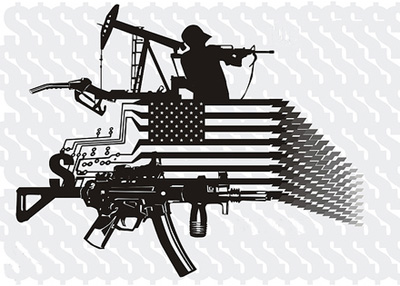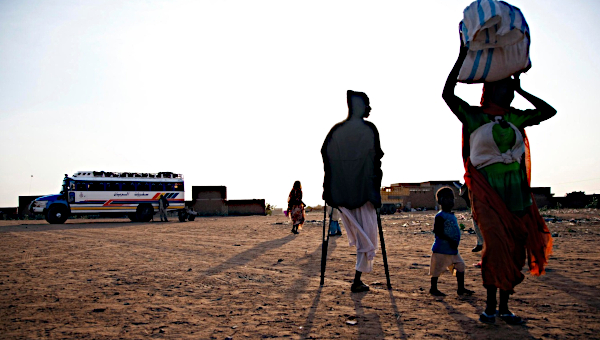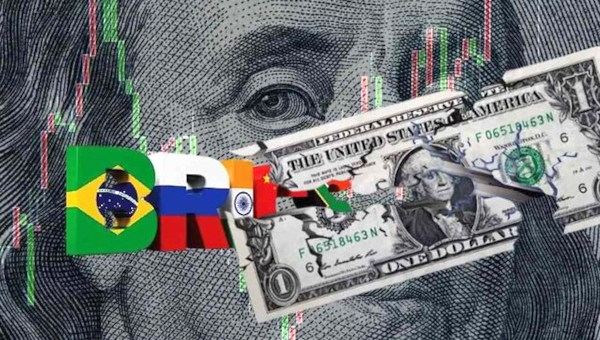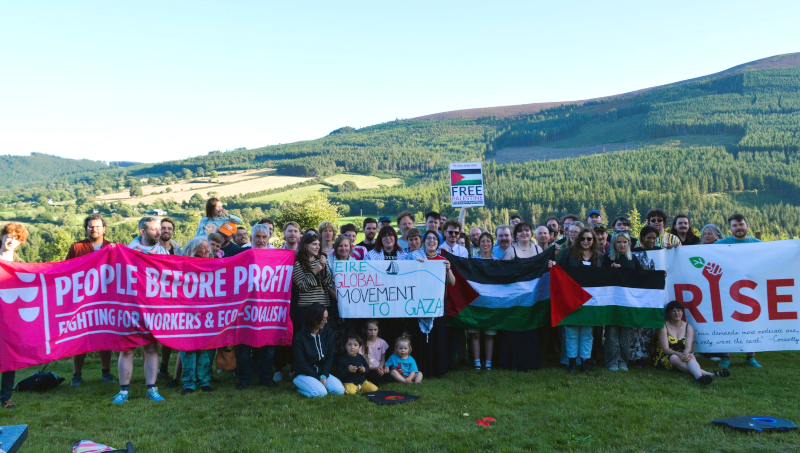Class and Capitalism in the Gulf
The Political Economy of the GCC
Adam Hanieh is a lecturer in development studies at SOAS, and is an editorial board member of Historical Materialism. He is the author, most recently, of Capitalism and Class in the Gulf Arab States. In conjunction with the most recent edition of the Socialist Register – The Crisis and the Left – New Left Project’s Ed Lewis interviewed Adam Hanieh about the international political economy of the Gulf Cooperation Council (GCC). This interview was first published on the New Left Project website.
Ed Lewis (EL): You see the six states of the Gulf Cooperation Council – Saudi Arabia, Kuwait, UAE, Qatar, Bahrain and Oman – as being at the centre of the Middle East economically and politically, but not simply because of their vast reserves of oil. What, then, is your account of how the Gulf states have come to be in this position of centrality?
Adam Hanieh (AH): There are a number of factors involved here. First, of course, is the question of oil. The GCC’s supplies of oil and gas are among the highest in the world. There are various estimates here – and the assessment of oil reserves is highly controversial – but a commonly cited figure is that the GCC holds about 40-45 per cent of global proven oil reserves and 20 per cent of world gas. It currently produces close to 20 per cent of the world’s total oil production. Given the centrality of fossil fuels – both as an energy source and feedstock for the petrochemical industry – this gives the region a vital importance to the patterns of accumulation in the global economy.
 A related factor is the huge levels of surplus capital that have accrued in the region as a result of sales of crude oil, gas and petrochemicals. These ‘petrodollars’ have been a key feature in the development of the global financial architecture. This is not a new aspect; during the 1970s financial flows from the Gulf were an essential part of the development of the Eurodollar markets (U.S. dollar deposits held in banks outside the United States) and also in supporting the purchases of U.S. Treasury bonds (see David Spiro‘s work on this). In this way, petrodollars have been key to buttressing U.S. dollar hegemony and in sustaining the global financial imbalances that have characterized the world market over recent decades. The rapid financialization of the global economy has thus been partly premised upon the integration of the GCC into the world market and its financial circuits.
A related factor is the huge levels of surplus capital that have accrued in the region as a result of sales of crude oil, gas and petrochemicals. These ‘petrodollars’ have been a key feature in the development of the global financial architecture. This is not a new aspect; during the 1970s financial flows from the Gulf were an essential part of the development of the Eurodollar markets (U.S. dollar deposits held in banks outside the United States) and also in supporting the purchases of U.S. Treasury bonds (see David Spiro‘s work on this). In this way, petrodollars have been key to buttressing U.S. dollar hegemony and in sustaining the global financial imbalances that have characterized the world market over recent decades. The rapid financialization of the global economy has thus been partly premised upon the integration of the GCC into the world market and its financial circuits.
What this means is that the way that the world market has developed over the last few decades, with complex production chains stretching from the manufacture of goods in low-wage zones to the sale of commodities in the advanced capitalist countries, depends heavily upon both the Gulf’s commodity production as well as its financial surpluses. In this sense, the nature of class and state formation in the GCC region has occurred alongside (and is very much linked to) the broader development of the capitalist world market.
These are the reasons for the GCC’s significance at the global scale. But within the Middle East and North Africa itself there have been some fundamental transformations over recent decades that cast a very particular character to the role of the Gulf within the region.
The most striking feature of the last two decades has been the generalization of neoliberal policies across most states of the region. This occurred in close collaboration with the World Bank and International Monetary Fund, regional groups like the World Economic Forum’s Arab Business Council and Regional Agenda Council on the Middle East and North Africa, and other bilateral institutions like USAID. Key among these neoliberal policies were the liberalization of ownership laws, particularly in the real estate, financial and telecommunication sectors; opening up to foreign investment flows; privatization of state-owned industries; restructuring of tax regimes; termination of subsidies on food and energy; and the relaxation of trade barriers.
At the national scale these policies have had a pronounced impact, leading to impoverishment of populations on one hand and the concentration of wealth on the other. There has been a large growth in the ‘informal’ sector in many Arab economies, as well as the movement of hundreds of thousands of people into urban areas (or across borders) as survival became difficult on the land. The tightened relationship of the MENA region with the world market – typified by a reliance on export-oriented development, migrant remittances and movements in food and energy prices – exposed many countries to the winds of the global economy. All of these factors are critical to appreciating how the region was hit by the 2008 economic crisis, and the possible impact of the ongoing turmoil in the global economy.
But most importantly, these neoliberal measures did not just reconfigure class power at the national scale. They have also been accompanied by the increasing significance and weight of the regional scale. It is not possible to understand the ‘nation-state’ in the Middle East as a self-contained political economy separate from the ways it intertwines with this broader regional scale. There are different aspects to this, but fundamental is the very rapid internationalization of GCC-based capital, particularly following the rising financial surpluses that began in 1999 and peaked in 2008. Of course the bulk of the GCC’s surplus capital continues to be invested outside the region. But, over the last two decades, much of these flows have been directed to other states in the Middle East. Viewed from the regional scale – the GCC has been a main beneficiary of the last decade or so of privatization, de-regulation and market opening.
A few quick statistics illustrate this. In the 2008-2010 period, according to the EU-based ANIMA database that tracks investment in the region, the GCC taken as a whole was the top-ranked source of FDI for Egypt, Jordan, Lebanon, Libya, Palestine, Tunisia and ranked second in Morocco and Syria. In 2010, GCC-based capital was responsible for the single largest FDI projects announced in Algeria, Lebanon, Libya and Tunisia. These are very striking figures. And they do not include portfolio investments in the region’s stock markets or other forms of ‘development loans’ that flow to the rest of the Middle East from the Gulf. It should also be noted that, contrary to common misconceptions, these flows are not necessarily directed by sovereign wealth funds or state-owned GCC companies. A large proportion of these flows come from privately owned GCC capital aimed at real estate projects, financial institutions, shopping malls, telecommunications and other investments.
The processes I’ve described were accentuated by the widening regional differentiation that arose in the wake of the 2008 economic crisis. In the GCC itself, although there were a few high profile financial casualties due to the heavy indebtedness of some large conglomerates, the crisis had the principal effect of strengthening the position of the Gulf’s dominant classes. The nature of class formation in the GCC (more on this below) permitted the displacement of crisis onto migrant workers and, coupled with state support to the largest Gulf financial and industrial entities, meant that Gulf elites were largely shielded from the worst impacts of the economic downturn.
The differentiated experience of the crisis across the region indicates not only the relative strengthening of the largest GCC conglomerates and ruling families within the Gulf itself, but also the widening gap between GCC and other Middle East states. This indicates that neoliberalism, when viewed from the regional scale, has both enriched individual national capitalist classes and, simultaneously, consolidated the position of the GCC within the region as a whole.
EL: How does the relationship between the GCC and the major external powers, primarily the U.S. but also others, now shape the inter-state politics of the Middle East?
AH: As noted above, the importance of the GCC to the world market has been strengthened with the deepening internationalization and financialization of capital at the global level. One indication of this is the eastward shift of Gulf oil, gas and petrochemical exports, which has played an important role in underpinning the rise of Chinese production. From 2000-2006, world energy consumption increased by close to 20 per cent, with China alone responsible for 45 per cent of the increase in the world’s global energy use during this period. By 2007, nearly 50 per cent of China’s crude oil imports came from the Middle East. Today, half of Saudi Arabia’s oil output goes to China, exceeding that of Saudi exports to the U.S., and by 2025, Chinese imports of Gulf oil are expected to be three times more than U.S. imports from the region. Alongside these hydrocarbon exports is the ongoing flow of GCC financial surpluses into the markets of the advanced capitalist countries.
In the context of a relative decline in U.S. power, and the emergence of an increasingly multi-polar world, this has meant that the GCC (and, by extension, the Middle East as a whole) is a key zone in how competitive rivalries between the leading capitalist states will play out. This is the reason for the central emphasis that long-term U.S. strategy places upon the tight military and political relationship with the GCC states. This relationship was forged in the post-World War 2 era, but continued to deepen through the 1980s (indeed, the actual formation of the GCC in 1981 was very much part of consolidating the Gulf states under a U.S. military umbrella in the context of the Iran-Iraq war). Dominance of the region was a key strategic factor in the U.S.-led invasions of Iraq and Afghanistan, and the ongoing struggles around control of Central Asia. The rising bellicosity against Iran also needs to be seen in this light. The announcement by the U.S. government a few weeks ago that it would be repositioning its military forces located in Iraq to the GCC is further confirmation of this. Already, the GCC hosts the U.S. Fifth Fleet (in Bahrain) and U.S. Central Command (CENTCOM) forward headquarters (in Qatar) – responsible for all U.S. military engagement, planning and operations across 27 countries from the Horn of Africa to Central Asia. The monarchies in the GCC are fully dependent upon U.S. military protection as well as univocal political support from the West (as the reaction to the uprising in Bahrain indicates). Of course there are rivalries and points of tension in the U.S.-GCC relationship (as there are between the states of the GCC itself), but the central point is that this relationship is a key feature of U.S. dominance at the global scale.
This is the overall framework for understanding how the U.S. and other foreign powers view the Middle East in its entirety. Other explanations – such as the vacuous and essentially liberal arguments about an ‘Israeli lobby’ that supposedly drives U.S. foreign policy making – should be rejected in my opinion.
But the rivalries of competing states in the capitalist world market also need to be seen alongside their shared interests. Class formation in the GCC is deeply interpenetrated with the development of capitalism as a whole, and the greatest fear of any of the leading states in the world market – and this, it should be stressed, includes China and Russia – is a significant challenge to that class structure. It is, in other words, a shared concern of all leading capitalist states to ensure that the GCC remains fully aligned with the interest of world capitalism. The policies of leading foreign powers in the Middle East thus have a dual character – on one hand, attempting to extend their individual competitive interests while, on the other, working cooperatively to prevent any popular challenge that would see the region’s wealth used to benefit the broad masses of people rather than a tiny parasitic social layer. This is the deeper meaning of the uprisings that have unfolded over this year.
EL: With the partial exception of Bahrain, the Gulf states are generally known for a very low level of political discontent, leaving its authoritarian regimes with a firm grip on power, despite very deep material inequalities. What accounts for this? Is it largely a result of domestic factors or is it significantly shaped by the relationship between the Gulf and the global order?
AH: There is a hidden and largely forgotten history of significant social struggles in the Gulf. From the 1950s to 1970s, there were several well-organized and militant Arab nationalist and left-wing movements across the region. The role of these movements could be seen, to mention only a few examples, in strikes and protests across the Saudi oil fields, the guerrilla struggle in the Dhofar region in Oman, and the widespread support in Kuwait and elsewhere for the Palestinian struggle. There was a strong sympathy among the Gulf populations for Palestinian and Arab nationalist causes, often linked to the presence of Arab workers from Palestine, Egypt, Syria, Yemen and so forth.
These movements were met with repression by the ruling monarchies (strongly backed by British and U.S. advisors). But in addition to this repression, there was also a transformation in the nature of the region’s labour markets that became evident through the 1980s and 1990s. During this time, particularly following the deportations that took place around the 1990-1991 Gulf War, there was a shift away from Arab workers toward temporary migrant workers from South and East Asia. These workers were brought on short-term contracts, often housed in camps away from the citizen population, and subject to severe restrictions on labour and political rights. In many cases, particularly in low-wage sectors such as construction, it was very difficult for these workers to bring their families with them.
Today, the Gulf states are distinguished by their very high reliance upon this type of temporary migrant labour, with around 70% of these workers from South and East Asia and 30% from the Middle East (the proportion had been essentially the opposite in the mid-1970s). These labour flows differ from the permanent migration flows seen in other areas of the world because they are short-term in nature, lack associated citizenship rights, and are focused on maximizing remittance flows back to the country of origin. In all of the GCC states, temporary migrant workers represent more than half of the entire labour force and in four of these states (Kuwait, Qatar, Oman and the UAE) the proportion is greater than eighty per cent. This heavy reliance on temporary labour flows closely ties the key labour exporting regions to accumulation patterns in the GCC.
The relative stability and adaptability of Gulf capitalism and its ruling elites is closely connected to this class structure. High levels of exploitation are enabled because a worker’s residency status is directly tied to holding a job. Once they become unemployed they become ‘illegal’ and are required to leave the country. In other words, because the right to be in the country is conditioned on employment, employers hold an enormous power differential over the worker. Moreover, generational reproduction of the class is highly fragmented because workers generally return home when they finish their contracts – class memory and bonds of solidarity are weak, and collective action very difficult to undertake. Legal restrictions codify these barriers to class-based action, with unions banned in Saudi Arabia and the UAE and severely restricted elsewhere.
Contrary to the generally accepted picture of these societies, relative poverty does exist among the citizen population in countries such as Saudi Arabia (and elsewhere in the Gulf). But the absence of a local, citizen working class means that political struggles lack an effective social base. Political conflict in these states (with the exception of Bahrain which I will discuss below) thus generally originates in inter-elite discord (such as between different branches of the ruling family, and the conflict between religious scholars and the monarchy) or Islamist movements – not from any widespread class struggle. This relative political calm can be contrasted with the situation in two oil-rich neighbouring countries, Iraq and Iran, where the working class has a long history of mobilization and persistent opposition to Western policies in the Gulf and wider Middle East.
The implications of this could be seen in the reaction to the 2008 economic crisis. In the immediate wake of the crisis, the Gulf states saw little popular protest or anger. It is certainly true that many high-profile projects were halted, consumer demand plummeted and businesses shut their doors – but the citizen population emerged relatively unscathed. Instead, there was a slowdown in hires of migrant workers and – in places such as Dubai – thousands were sent home. This meant that the real pain of the crisis was felt by the swelling numbers of unemployed across the Gulf’s surrounding regions.
Bahrain, however, is an important partial exception to this pattern. It has less oil wealth than other GCC states (only 0.03% of proven GCC reserves), and the peculiarities of its historical development meant that a significant sectarian divide was established between a largely Sunni ruling elite (dominated by the Al Khalifa monarchy) and a majority Shi’a population. Yet Bahrain’s social structure is not a question of some obdurate religious conflict between Shi’a and Sunni (as it is usually portrayed in the media and purposively promoted by the Bahraini monarchy). Rather, the discrimination against the country’s Shi’a majority cannot be understood separate from the ways in which class formed. While the country continues to rely heavily upon migrant labour – in 2005, around 58% of the Bahraini population were non-citizen migrant workers – much of its Shi’a majority remain unemployed, poor and face entrenched, systemic discrimination.
Over recent years Bahrain has also endured a lengthier and more advanced experience of neoliberalism (relative to other GCC states). This has deeply accentuated the unevenness of capitalist development – widening gaps between poorer citizens (concentrated among Shi’a) and the private sector and state elites that have benefitted from Bahrain’s position as the “freest economy in the Middle East” (according to the Heritage Foundation 2010 Index of Economic Freedom). In 2004, the Bahrain Centre for Human Rights estimated that over half of Bahraini citizens were living in poverty and yet, simultaneously, the richest 5200 Bahrainis had a combined wealth greater than $20-billion. The more proletarianized character of the Bahraini citizen population, which overlaps with the sectarian discrimination and has been reinforced by the deep impact of neoliberalism, has meant that labour and left-wing movements remain significant within the country. Every few years there have been major uprisings and labour strikes in the country – the intifada of 2011 is the latest of these movements.
Moreover, the significance of Bahrain extends beyond the country itself. There is a sizeable Shi’a population in Saudi Arabia’s oil-rich Eastern Province – just across from Bahrain. There were protests in this region in early 2011, and there exists a great fear among all the Gulf states (and the Western powers that support them) that a successful movement in Bahrain would quickly detonate similar struggles in Saudi Arabia and elsewhere. This explains the furious repression that has been unleashed on the Bahraini people over 2011, including the sending of Saudi, UAE and Qatari troops to the country in an attempt to quell the uprising. But we can be sure that the story of Bahrain’s uprisings is far from over.
EL: How important is the battle over oil prices? What interests are at stake, and how does it shape regional states’ policies and the external policies of foreign powers (like the USA)?
AH: The factors determining the price of oil are related to availability and supply of different oil grades and other energy sources, global demand, levels of capital investment in the industry, speculation, and the political situation in the Middle East. There has been a generally upward movement in the price since 1999 (punctuated by a large fall in the immediate wake of the 2008 economic crisis) and, if the most common estimates of global supply and demand are accurate, the price will likely remain high into the mid-term future.

High prices of oil are strongly correlated with recessionary periods and, as the 1970s showed, those countries that are reliant upon oil imports can be badly hit by high prices. Indeed, this was a major factor (partly facilitated through the recycling of Gulf petrodollars) in the explosion of Southern debt from the 1970s onwards. The further trend of rising food prices in the current period (partially linked to the price of hydrocarbons) means that the impact of high oil prices can be devastating in multiple ways.
The other side to this, however, is the interest of the Gulf states (and, of course, oil companies) in a higher price. There are various estimates of the ‘break even’ points for the GCC states – the necessary price of oil for these states to meet their fiscal requirements. The IMF estimated in 2008 that Saudi Arabia needed oil at $49/barrel to balance its fiscal account for the year. The lower range of the IMF estimates for the GCC was the UAE ($23) and Kuwait ($33) and the highest were found in Bahrain ($75) and Oman ($77). The GCC as a whole averaged $47/barrel. However, these estimates are probably too low. We need to remember that the GCC states have launched a massive program of government spending in the wake of the uprisings to undercut any dissent within their countries. The Institute of International Finance, a peak-body association of the world’s largest banks, estimated in March 2011 that Saudi Arabia would need oil to sell at an average of $88/barrel in 2011 for government spending to break even. Saudi Arabia is a key producer because it is one of the few states with the ability to increase supply to the world market and thus lower the price of oil (although some industry analysts question to what extent this is really possible and claim that Saudi reserves have been overstated). In short, there are many different factors that are complexly inter-related here. But I think the likely scenario in the near future is a continued high price and persistent growth in the surpluses of the GCC states.
EL: Could the ‘Arab Spring’ serve to threaten the regional balance of power as well as the balance of class forces that prevail within the Gulf states?
AH: This is absolutely the real potential of the uprisings through 2011. The two processes I’ve described above – the increasing weight of the regional economy and the differentiated impact of the global crisis – mean that it is impossible to treat the national and regional scales as two distinct political spheres. What appear on the surface to be ‘national’ struggles that are contained within individual nation-states, inevitably grow to confront the construction of these broader regional hierarchies. This is the context in which the Arab uprisings have unfolded.
There are different aspects to this. On the one hand we can see the role of the U.S. and other foreign powers in the region and, very importantly, the position of Israel. The uprisings (particularly that of Egypt) confront all of these features because the regimes that are being challenged were central to how this regional order was constructed. It is thus wrong to see the uprisings as solely a question of ‘democracy’ – as if the ‘political’ can be separated from the ‘economic’ or the ‘national’ from the ‘regional.’
Likewise with the role that the GCC states play in the regional political economy. I am not claiming that the slogans and demands of the uprisings explicitly target the GCC states in this manner (or, indeed, Israel or the U.S.), but contained within their logic is an implicit challenge to the regional order as it has developed over the last two decades. The social structures that characterized political rule in Egypt, Tunisia and elsewhere are themselves part of how the GCC – linked to the domination of foreign powers and the position of Israel – established its place atop the hierarchies of the regional market. The struggles against dictatorship that the uprisings represent are, simultaneously, intertwined with the way that capitalism has developed across the region and, in this sense, are also struggles against the Gulf.
This explains the furious attempts by the GCC states to hold back and derail these uprisings – they are absolute central to the counter-revolutionary wave that is being unleashed today in the region. I think a convincing case can be made that imperialism in the region is articulated with – and largely works through – the GCC states. The NATO-led invasion of Libya is a clear example of this, with Qatar and the UAE, in particular, playing a very important role in this invasion. The Gulf states sent troops, money and equipment and – perhaps most importantly – provided the political legitimacy for this attack. There are many other examples – we can see it in the billions of dollars that are being promised by the Gulf states to the regimes in Egypt and Tunisia; the military intervention in Bahrain; the offer made to Jordan and Morocco to join the GCC (thereby bringing together all the reactionary monarchies in the region within a single bloc); and the centrality of the GCC to attempting to mediate and steer the uprisings in Syria and Yemen. And, perhaps most significantly, the rising threats that are being made against Iran. Indeed, the question of Iran is just as much a question of the GCC as it is of Israel.
So yes, the uprisings present a real possibility of shifting the regional order. Egypt, with its large, better organized working class and much stronger Left organizations is the key point of struggle. But to return to the themes above, in the long-run there are no ‘national’ solutions to the broader problems of uneven development facing the Middle East and North Africa. These require a pan-regional solution and, centrally, that means confronting the position of the GCC states as the core of capitalism in the region. •






